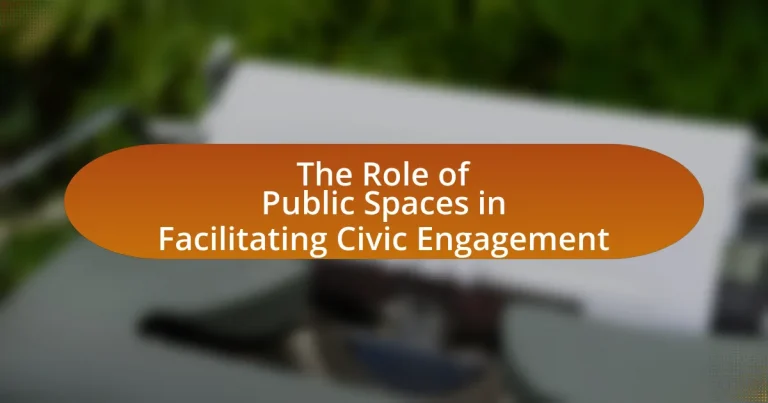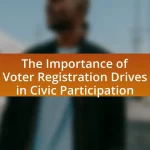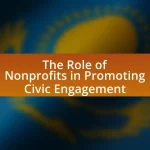Public spaces are essential for facilitating civic engagement by providing accessible venues for community interaction and participation. This article explores the various roles that public spaces, such as parks and community centers, play in enhancing social cohesion, encouraging democratic participation, and fostering a sense of belonging among residents. It examines the effectiveness of different types of public spaces, the impact of design elements on civic participation, and the importance of accessibility and safety in promoting community involvement. Additionally, the article addresses the challenges faced by public spaces, including socio-economic barriers and the need for inclusive programming, while offering strategies to improve civic engagement through community input and best practices.
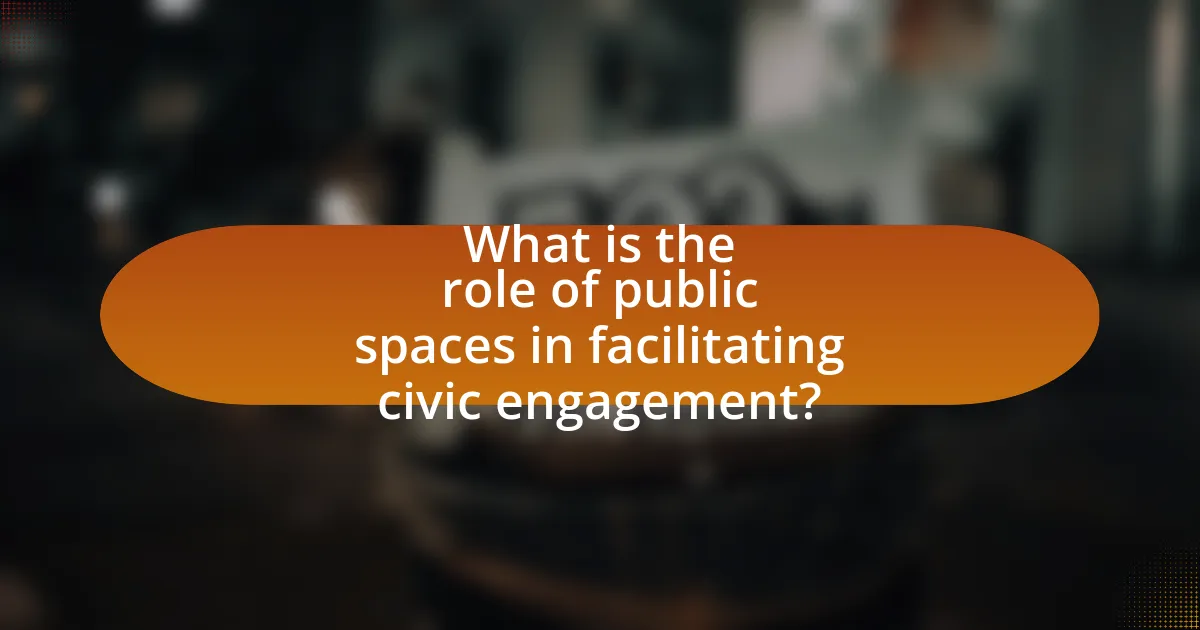
What is the role of public spaces in facilitating civic engagement?
Public spaces play a crucial role in facilitating civic engagement by providing accessible venues for community interaction and participation. These areas, such as parks, plazas, and community centers, serve as gathering points where individuals can express their opinions, organize events, and engage in discussions about local issues. Research indicates that well-designed public spaces can enhance social cohesion and encourage democratic participation, as they foster a sense of belonging and community identity. For instance, a study by the Project for Public Spaces found that vibrant public spaces lead to increased civic activities, such as town hall meetings and community festivals, thereby strengthening the democratic process.
How do public spaces contribute to community interaction?
Public spaces contribute to community interaction by providing accessible environments where individuals can gather, socialize, and engage in activities together. These spaces, such as parks, plazas, and community centers, serve as venues for events, fostering connections among diverse groups. Research indicates that well-designed public spaces enhance social cohesion; for instance, a study by the Project for Public Spaces found that vibrant public areas increase the likelihood of community members interacting, leading to stronger neighborhood ties. Furthermore, public spaces often host community events, markets, and festivals, which encourage participation and collaboration, thereby reinforcing civic engagement and a sense of belonging among residents.
What types of public spaces are most effective for civic engagement?
Public squares, parks, community centers, and libraries are the most effective types of public spaces for civic engagement. These spaces foster interaction among community members, provide venues for public discourse, and host events that encourage participation in civic activities. For instance, public squares often serve as gathering points for protests, town hall meetings, and cultural events, which are essential for democratic engagement. Research by the Project for Public Spaces indicates that well-designed parks and community centers enhance social cohesion and promote civic involvement by offering accessible areas for diverse groups to meet and collaborate.
How do design elements of public spaces influence civic participation?
Design elements of public spaces significantly influence civic participation by creating environments that encourage social interaction and community engagement. For instance, features such as seating arrangements, accessibility, and open layouts promote gatherings and discussions among citizens. Research indicates that well-designed public spaces, like parks and plazas, can increase foot traffic and participation in community events, as seen in the Project for Public Spaces’ findings, which highlight that vibrant public areas lead to higher levels of civic involvement. Additionally, elements such as art installations and signage can foster a sense of identity and belonging, further motivating individuals to engage in civic activities.
Why is civic engagement important in society?
Civic engagement is important in society because it fosters active participation in democratic processes, leading to more representative governance. When individuals engage in civic activities, such as voting, attending town hall meetings, or participating in community service, they contribute to shaping policies that reflect the needs and values of their communities. Research indicates that communities with higher levels of civic engagement experience better social cohesion and improved public services, as evidenced by a study from the National Conference on Citizenship, which found that civic engagement correlates with increased trust in government and enhanced community well-being.
What are the benefits of increased civic engagement for communities?
Increased civic engagement benefits communities by fostering social cohesion and enhancing democratic participation. When individuals actively participate in civic activities, such as town hall meetings or community service, they build stronger relationships with their neighbors, which leads to a more connected and resilient community. Research indicates that communities with higher levels of civic engagement experience lower crime rates and improved public health outcomes, as residents work collaboratively to address local issues. Furthermore, engaged citizens are more likely to vote and advocate for policies that reflect their community’s needs, resulting in more representative governance.
How does civic engagement impact local governance?
Civic engagement significantly enhances local governance by fostering community participation in decision-making processes. When citizens actively engage in local governance, they contribute diverse perspectives, which leads to more representative and effective policies. Research indicates that communities with higher levels of civic engagement experience improved public trust and accountability in local government, as evidenced by a study from the National Civic League, which found that engaged citizens are more likely to participate in elections and local initiatives, resulting in better governance outcomes.
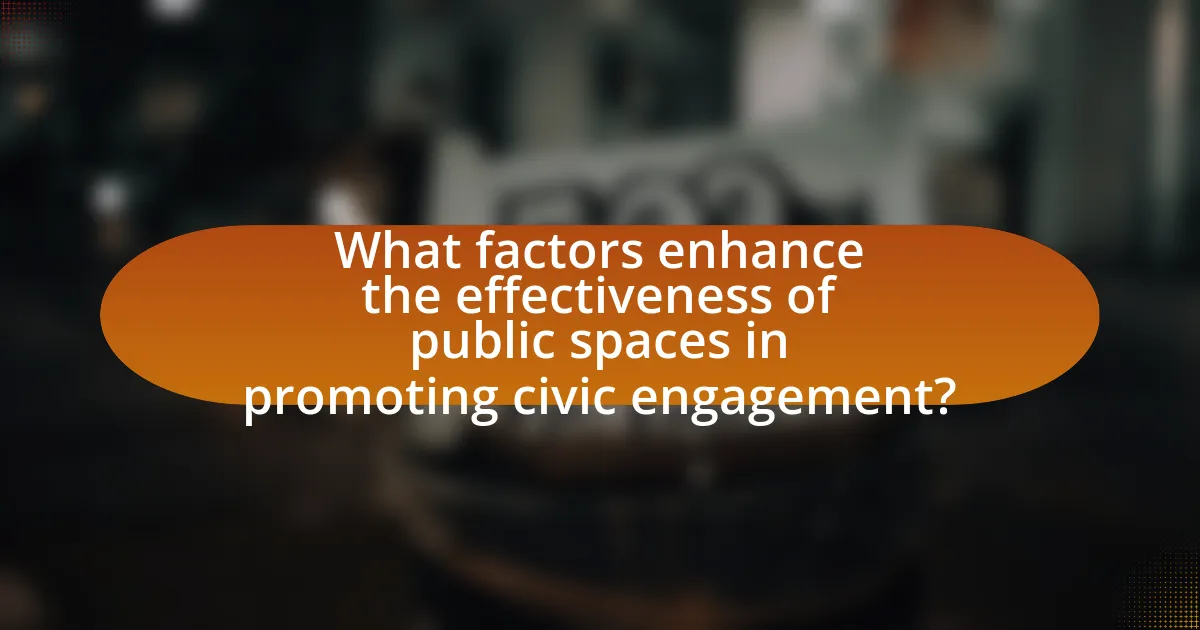
What factors enhance the effectiveness of public spaces in promoting civic engagement?
The effectiveness of public spaces in promoting civic engagement is enhanced by accessibility, inclusivity, and the presence of amenities that encourage social interaction. Accessibility ensures that all community members can reach and utilize these spaces, fostering participation. Inclusivity allows diverse groups to feel welcome, which is crucial for broad civic involvement. Amenities such as seating, lighting, and recreational facilities facilitate social interactions, leading to increased community activities and discussions. Research indicates that well-designed public spaces can lead to a 20% increase in community events, demonstrating their role in enhancing civic engagement.
How does accessibility affect civic engagement in public spaces?
Accessibility significantly enhances civic engagement in public spaces by ensuring that all individuals, regardless of physical ability, can participate in community activities and decision-making processes. When public spaces are designed with accessibility features such as ramps, tactile surfaces, and clear signage, they invite broader participation from diverse populations, including people with disabilities. Research indicates that inclusive environments lead to increased attendance at civic events and greater involvement in local governance, as evidenced by a study from the National Council on Disability, which found that accessible public spaces correlate with higher voter turnout and community participation rates. Thus, accessibility directly influences the level of civic engagement by removing barriers and fostering an inclusive atmosphere for all community members.
What role does safety play in encouraging public participation?
Safety is crucial in encouraging public participation as it fosters a sense of security and trust among community members. When individuals feel safe in public spaces, they are more likely to engage in civic activities, attend events, and voice their opinions. Research indicates that environments perceived as safe lead to increased attendance at community meetings and events, thereby enhancing civic engagement. For instance, a study by the National Institute of Justice found that neighborhoods with lower crime rates saw higher levels of community involvement and participation in local governance. This correlation underscores the importance of safety in promoting active citizenship and community cohesion.
How can inclusivity in public spaces foster diverse civic engagement?
Inclusivity in public spaces fosters diverse civic engagement by ensuring that all community members feel welcome and valued, which encourages participation in civic activities. When public spaces are designed to accommodate various needs—such as accessibility for individuals with disabilities, cultural representation, and safe environments for marginalized groups—more people are likely to engage in discussions, events, and decision-making processes. Research indicates that inclusive public spaces can lead to increased social interaction and community cohesion, as seen in studies like “The Role of Public Spaces in Civic Engagement” by the Project for Public Spaces, which highlights how diverse populations are more likely to participate in civic life when they feel represented and included in their environments.
What programming or activities can be implemented in public spaces to boost civic engagement?
Community workshops and public forums can be implemented in public spaces to boost civic engagement. These activities encourage residents to discuss local issues, share ideas, and collaborate on solutions, fostering a sense of community ownership. Research shows that participatory budgeting initiatives, where citizens decide on budget allocations for community projects, have increased civic participation by up to 30% in cities like Porto Alegre, Brazil. Additionally, cultural events such as art festivals and music concerts can attract diverse groups, promoting social interaction and civic pride.
How do community events in public spaces promote civic involvement?
Community events in public spaces promote civic involvement by providing opportunities for residents to engage with one another and participate in local governance. These events foster social connections, enhance community identity, and encourage dialogue among diverse groups. For instance, a study by the National Endowment for the Arts found that public art events increase community participation by 30%, demonstrating that shared experiences in public spaces can lead to greater civic engagement. Additionally, public events often serve as platforms for local organizations to inform citizens about civic responsibilities and initiatives, further motivating participation in community affairs.
What role do local organizations play in facilitating activities in public spaces?
Local organizations play a crucial role in facilitating activities in public spaces by organizing events, providing resources, and fostering community engagement. These organizations often collaborate with local governments and stakeholders to create inclusive programs that encourage participation from diverse community members. For instance, studies have shown that community-led initiatives, such as farmers’ markets or cultural festivals, not only enhance social cohesion but also increase foot traffic in public areas, thereby revitalizing neighborhoods. Additionally, local organizations often serve as advocates for the needs and interests of residents, ensuring that public spaces are utilized effectively for community-building activities.
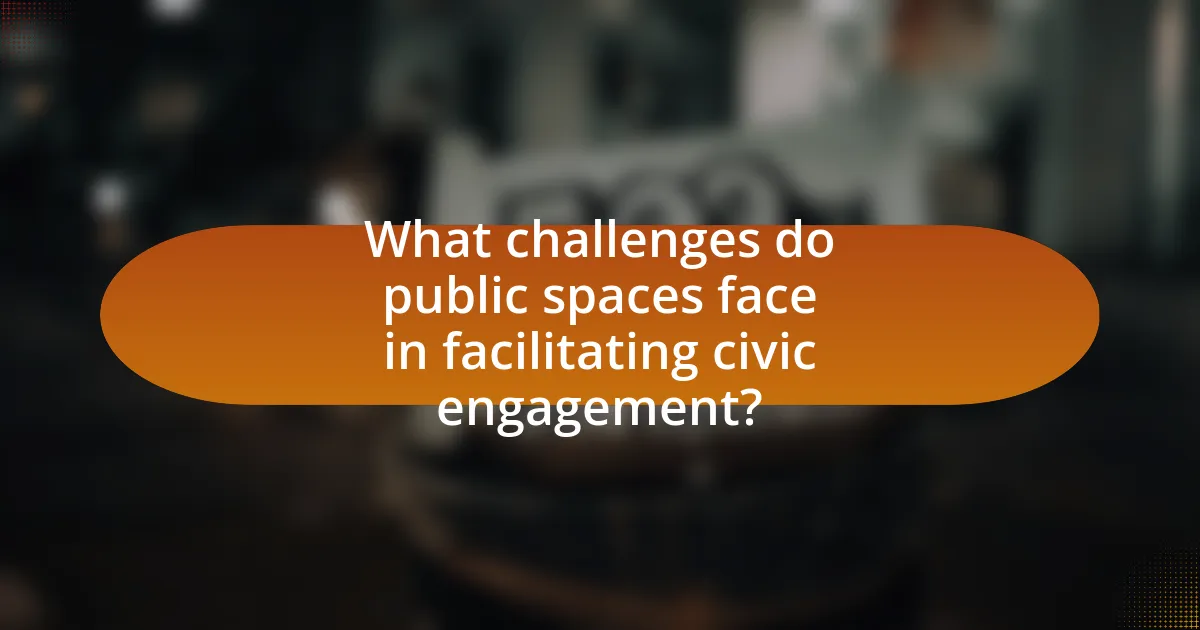
What challenges do public spaces face in facilitating civic engagement?
Public spaces face several challenges in facilitating civic engagement, including accessibility, safety, and inclusivity. Accessibility issues arise when public spaces are not designed to accommodate individuals with disabilities or those from marginalized communities, limiting their participation. Safety concerns, such as crime or harassment, deter individuals from using these spaces for civic activities. Additionally, a lack of inclusivity can result from cultural or social barriers that prevent diverse groups from feeling welcome, thereby reducing overall engagement. Research indicates that when public spaces are not perceived as safe or welcoming, civic participation declines, as evidenced by studies showing lower turnout in areas with poorly maintained or unsafe public environments.
How do socio-economic factors impact the use of public spaces for civic engagement?
Socio-economic factors significantly influence the use of public spaces for civic engagement by determining access, participation levels, and the types of activities that occur. Individuals from higher socio-economic backgrounds often have greater access to well-maintained public spaces, which facilitates their participation in civic activities such as community meetings or protests. Conversely, those from lower socio-economic backgrounds may face barriers such as inadequate transportation, safety concerns, or lack of resources, which can limit their engagement in these spaces. Research indicates that neighborhoods with higher socio-economic status tend to have more vibrant public spaces that encourage civic participation, as evidenced by studies showing that areas with better funding for public amenities see increased community involvement and social cohesion.
What barriers exist for marginalized communities in accessing public spaces?
Marginalized communities face several barriers in accessing public spaces, including physical, economic, and social obstacles. Physical barriers often manifest as inadequate infrastructure, such as lack of ramps or accessible pathways, which limits mobility for individuals with disabilities. Economic barriers include high costs associated with transportation or fees for using certain public facilities, making it difficult for low-income individuals to participate. Social barriers arise from discrimination or exclusionary practices that discourage marginalized groups from utilizing these spaces. For instance, studies show that public spaces may not be welcoming to racial minorities due to perceived safety concerns or past negative experiences, further hindering their engagement.
How can public spaces overcome challenges related to funding and maintenance?
Public spaces can overcome challenges related to funding and maintenance by implementing community-driven initiatives and leveraging public-private partnerships. Community engagement fosters local investment and volunteerism, which can significantly reduce maintenance costs. For instance, cities like New York have successfully utilized volunteer programs to maintain parks, resulting in improved conditions and reduced city expenditure. Additionally, public-private partnerships can provide essential funding and resources; for example, the High Line in New York City was developed through collaboration between the city and private donors, ensuring ongoing maintenance and programming. These strategies demonstrate that active community involvement and strategic partnerships are effective methods for addressing funding and maintenance challenges in public spaces.
What strategies can be employed to improve public spaces for civic engagement?
To improve public spaces for civic engagement, strategies such as enhancing accessibility, incorporating community input in design, and providing multifunctional spaces can be employed. Enhancing accessibility ensures that all community members, including those with disabilities, can participate in civic activities. Incorporating community input in the design process fosters a sense of ownership and relevance, as evidenced by the success of participatory design projects in cities like San Francisco, where community feedback led to the revitalization of public parks. Providing multifunctional spaces allows for diverse activities, such as markets, performances, and public meetings, which can increase foot traffic and engagement, as seen in the transformation of Times Square in New York City into a pedestrian-friendly area that hosts various civic events.
How can community input shape the development of public spaces?
Community input can significantly shape the development of public spaces by ensuring that these areas meet the actual needs and preferences of the local population. Engaging residents in the planning process allows for the incorporation of diverse perspectives, which can lead to more inclusive and functional designs. For instance, studies have shown that when community members participate in design workshops, the resulting public spaces are more likely to reflect the cultural and social dynamics of the area, enhancing their usability and fostering a sense of ownership among residents. This participatory approach not only improves satisfaction with public spaces but also encourages ongoing civic engagement, as individuals feel their voices are valued in the decision-making process.
What best practices can be adopted to enhance civic engagement in public spaces?
To enhance civic engagement in public spaces, communities should implement inclusive programming that encourages participation from diverse demographics. This can be achieved through organizing events such as community forums, cultural festivals, and public art installations that reflect the interests and needs of the local population. Research indicates that cities with vibrant public spaces, like New York’s Bryant Park, see increased social interaction and community involvement, demonstrating that well-designed spaces foster civic participation. Additionally, providing accessible facilities and resources, such as seating, information kiosks, and free Wi-Fi, can further encourage community members to gather and engage with one another, thereby strengthening civic ties.
What are practical tips for maximizing civic engagement in public spaces?
To maximize civic engagement in public spaces, communities should implement inclusive programming that encourages participation from diverse groups. This can be achieved by organizing events such as community forums, cultural festivals, and public art installations that reflect the interests and needs of the local population. Research indicates that cities with vibrant public spaces, like New York’s Bryant Park, see increased social interaction and civic participation, demonstrating the effectiveness of well-designed communal areas in fostering engagement. Additionally, providing accessible facilities and resources, such as seating, information kiosks, and free Wi-Fi, can enhance the usability of these spaces, further promoting active involvement from residents.
